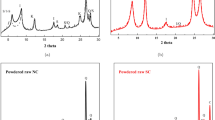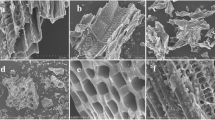Abstract
The engineering characteristics of clay are dependant on its mineral and chemical structure. When the clay soils interacted with water, their volume and shear strength and compressibility properties change gradually. Large amount of decrease in terms of the shear strength of clay soils due to swelling is observed. In order to solve these problems, the stabilization of clay soils using chemical additives is a prevalent subject of research. In view of this, previous research studies have employed surface active surfactants to modify the fundamental properties of soft clays. In this study, surfactant–clay complexes (organoclays) were developed using a raw clay modification with four surfactants and their geotechnical properties were determined in laboratory conditions. Two of the surfactants are cationic (cetyl trimethyl ammonium chloride, denoted as CTAC and quaternised ethoxylated fatty amine, denoted as QEFA) and the others are anionic (linear alkylbenzene sulphonic acid, denoted as LABSA and sodium lauryl ether sulfate, denoted as SLES). The experimental results indicated that the geotechnical properties of organoclays show significant change when compared to those of natural clay. The specific gravities, unconfined compression strengths and maximum dry densities of all organoclays were decreased. Optimum moisture content and swelling pressure values were decreased in cationic surfactant modified clays. However, the optimum moisture content and swelling pressure values of anionic surfactant clays are increased. A direct shear test was performed to determine the shear strength of organoclays. The test results also showed that the internal friction angles of organoclays were increased. Additionally, the change in the hydraulic conductivity was found to be insignificant.










Similar content being viewed by others
References
Akbulut S, Kurt Z N and Arasan S 2010a Electrokinetic properties of surfactant modified clays. Int. J. Civil and Struct. Eng. 1(3): 354–361
Akbulut S, Arasan S and Kurt Z N 2010b Some geotechnical properties of two organoclays. Indian Geotechnical Conference IGC-2010 Geotrendz India
Akbulut S, Arasan S and Acikyildiz M 2010c Water affinity of surfactant modified clay. Proceedings of the First Makassar International Conference on Civil Engineering (MICCE2010), ISBN 978-602-95227-0-9
Akbulut S, Hamutcu U, Arasan S and Kurt Z N 2010d A research on some geotechnical properties of organoclay that has been developed at laboratory. 13th National Soil Mechanic and Foundation Engineering Congress, Istanbul, Turkey (in Turkish with an English summary)
Akbulut S, Arasan S, Kurt Z N and Pekdemir Y 2011 Consolidation properties of some organoclays (under review)
Akbulut S, Kurt Z N and Arasan S 2013 Contact angle and consistency limits of surfactant modified clays. Earth Sciences Research Journal 16(2) (accepted for publication)
Al-Asheh S, Banat F and Abu-Aitah L 2003 Adsorption of phenol using different types of activated bentonites. Sep. Purif. Technol. 33: 1–10
Ashmawy A K, El-Hajji D, Sotelo N and Muhammad N 2002 Hydraulic performance of untreated and polymer-treated bentonite in inorganic landfill leachates. Clays and Clay Minerals 50: 546–552
ASTM D 698 2000 Standard test methods for laboratory compaction characteristics of soil using standard effort. ASTM West Conshohocken, PA
ASTM D 2166 2000 Standard test method for unconfined compressive strength of cohesive soil. ASTM West Conshohocken, PA
ASTM D 5856 2007 Standard test method for measurement of hydraulic conductivity of porous material using a rigid-wall, compaction-mold permeameter. ASTM West Conshohocken, PA
ASTM D 4546 2008 Standard test methods for one-dimensional swell or collapse of cohesive soils. ASTM West Conshohocken, PA
ASTM D 4892 2009 Standard test method for density of solid pitch (Helium Pycnometer Method). ASTM West Conshohocken, PA
ASTM D 3080 2011 Standard test method for direct shear test of soils under consolidated drained conditions. ASTM West Conshohocken, PA
Bate B 2010 Engineering behavior of fine-grained soils modified with a controlled organic phase. PhD. Thesis, Atlanta, Georgia: Georgia Institute of Technology
Budhu M, Giese R F and Van Oss J 1997 Surface thermodynamics and some engineering properties of an organo clay. J. Geotechnical & Geoenvironmental Eng. 123: 580–587
Cipriano B H, Raghavan S R and McGuiggan P M 2005 Surface tension and contact angle measurements of a hexadecyl imidazolium surfactant adsorbed on a clay surface. Colloids and Surfaces A: Physicochemical and Engineering Aspects 262(1–3): 8–13
Denham W T 1999 The hydraulic conductivity and adsorptivity of clay barriers materials containing organoclay. Ms Thesis, Vancouver, Canada: The University of British Columbia
Fu X and Qutubuddin S 2000 Synthesis of polystyrene–clay nanocomposites. Materials Letters 42: 12–15
Gates W P, Nefiodovas A and Peter P 2004 Permeability of an organo-modified bentonite to ethanol-water solutions. Clays and Clay Minerals 52(2): 192–203
Ghiaci M, Abbaspur A, Kia R and Seyedeyn-Azad F 2004 Equilibrium isotherm studies for the sorption of benzene, toluene, and phenol onto organo-zeolites and as-synthesized MCM-41. Sep. Purif. Technol. 40: 217–229
Gungor N, Alemdar A, Atici O and Ece I O 2001 The effect of SDS surfactant on the flow and zeta potential of bentonite suspensions. Materials Letters 51: 250–254
Gurses A, Karaca S, Acikyildiz M and Ejder Korucu M 2009 Thermodynamics and mechanism of cetyltrimethylammonium adsorption onto clayey soil from aqueous solutions. Chemical Eng. J. 147: 194–201
He H, Ding Z, Zhu J, Yuan P, Xi Y, Yang D and Frost R L 2005 Thermal characterization of surfactant-modified montmorillonites. Clays and Clay Minerals 53: 287–293
Isci S, Gunister E, Alemdar A, Ece O I and Gungor N 2008 The influence of DTABr surfactant on the electrokinetic and rheological properties of soda-activated bentonite dispersions. Materials Letters 62: 81–84
Kalkan E and Bayraktutan M S 2008 Geotechnical evaluation of Turkish clay deposits: a case study in Northern Turkey. Environmental Geology 55: 937–950
Kenney T C, van Veen W A, Swallow M A and Sungaila M A 1992 Hydraulic conductivity of compacted bentonite-sand mixtures. Can. Geotech. J. 29: 364–374
Li Z, Willms C A and Kniola K 2003 Removal of anionic contaminants using surfactant-modified palygorskite and sepiolite. Clays and Clay Minerals 51: 445–451
Liu R, Frost R L, Martens W N and Yuan Y 2008 Synthesis, characterization of mono, di and tri alkyl surfactant intercalated Wyoming montmorillonite for the removal of phenol from aqueous systems. J. Colloid and Interface Science 32(2): 287–294
Lo I M C 2001 Organoclay with soil–bentonite admixture as waste contaminant barriers. J. Environ. Eng. 127: 154–161
Matott L S, Bartelt-Hunt S L, Rabideau A J and Fowler K R 2006 Application of heuristic optimization techniques and algorithm tuning to multilayered sorptive barrier design. Environ. Sci. Technol. 40: 6354–6360
Mulligan C N, Yong R N and Gibbs B F 1999a On the use of biosurfactants for the removal of heavy metals from oil-contaminated soil. Environ. Prog. 18: 31–35
Mulligan C N, Yong R N and Gibbs B F 1999b Removal of heavy metals from contaminated soil and sediments using the biosurfactant surfactin. J. Soil Contam. 8: 231–254
Mulligan C N, Yong R N and Gibbs B F 2001 Surfactant-enhanced remediation of contaminated soil: a review. Eng. Geol. 60: 371–380
Park J, Vipulanandan C, Kim J W and Oh M H 2006 Effects of surfactants and electrolyte solutions on the properties of soil. Environ. Geol. 49: 977–989
Tjong S C 2006 Structural and mechanical properties of polymer nanocomposites. Materials Science and Engineering 53: 73–197
Tuncan A, Tuncan M, Yalcin M and Guney Y 1998 The effects of environmental pollution on cyclic swell and shrink behaviour of Na-bentonite clay. Proc. 3rd Int. Congr on Environmental Geotechnics 2: 57–62
Wibulswas R 2004 Batch and fixed bed sorption of methylene blue on precursor and QACs modified montmorillonite. Sep. Purif. Technol. 39: 3–12
Xi Y, Zhou Q, Frost R L and He H 2007 Thermal stability of octadecyltrimethylammonium bromide modified montmorillonite organoclay. J. Colloid and Interface Science 311(2): 347–353
Yang J W, Lee Y J, Park J Y, Kim S J and Lee J Y 2005 Application of APG and Calfax 16 L-35 on surfactant-enhanced electrokinetic removal of phenanthrene from kaolinite. Eng. Geol. 77: 243–251
Yılmaz G, Yetimoglu T and Arasan S 2008 Hydraulic conductivity of compacted clay liners permeated with inorganic salt solutions. Waste Management & Research 26: 464–473
Zhou L, Chen H, Jiang X, Lu F, Zhou Y, Yin W and Ji X 2009 Modification of montmorillonite surfaces using a novel class of cationic gemini surfactants. J. Colloid and Interface Science 332: 16–21
Zhu L, Li Y and Zhang J 1997 Sorption of organo-bentonites to some organic pollutants in water. Environ. Sci. Technol. 31: 1407–1410
Acknowledgement
The financial support from the Scientific and Technological Research Council of Turkey (TUBITAK) (grant No. 107Y295) is gratefully acknowledged.
Author information
Authors and Affiliations
Corresponding author
Rights and permissions
About this article
Cite this article
AKBULUT, S., KURT, Z.N., ARASAN, S. et al. Geotechnical properties of some organoclays. Sadhana 38, 317–329 (2013). https://doi.org/10.1007/s12046-013-0120-x
Received:
Revised:
Accepted:
Published:
Issue Date:
DOI: https://doi.org/10.1007/s12046-013-0120-x




